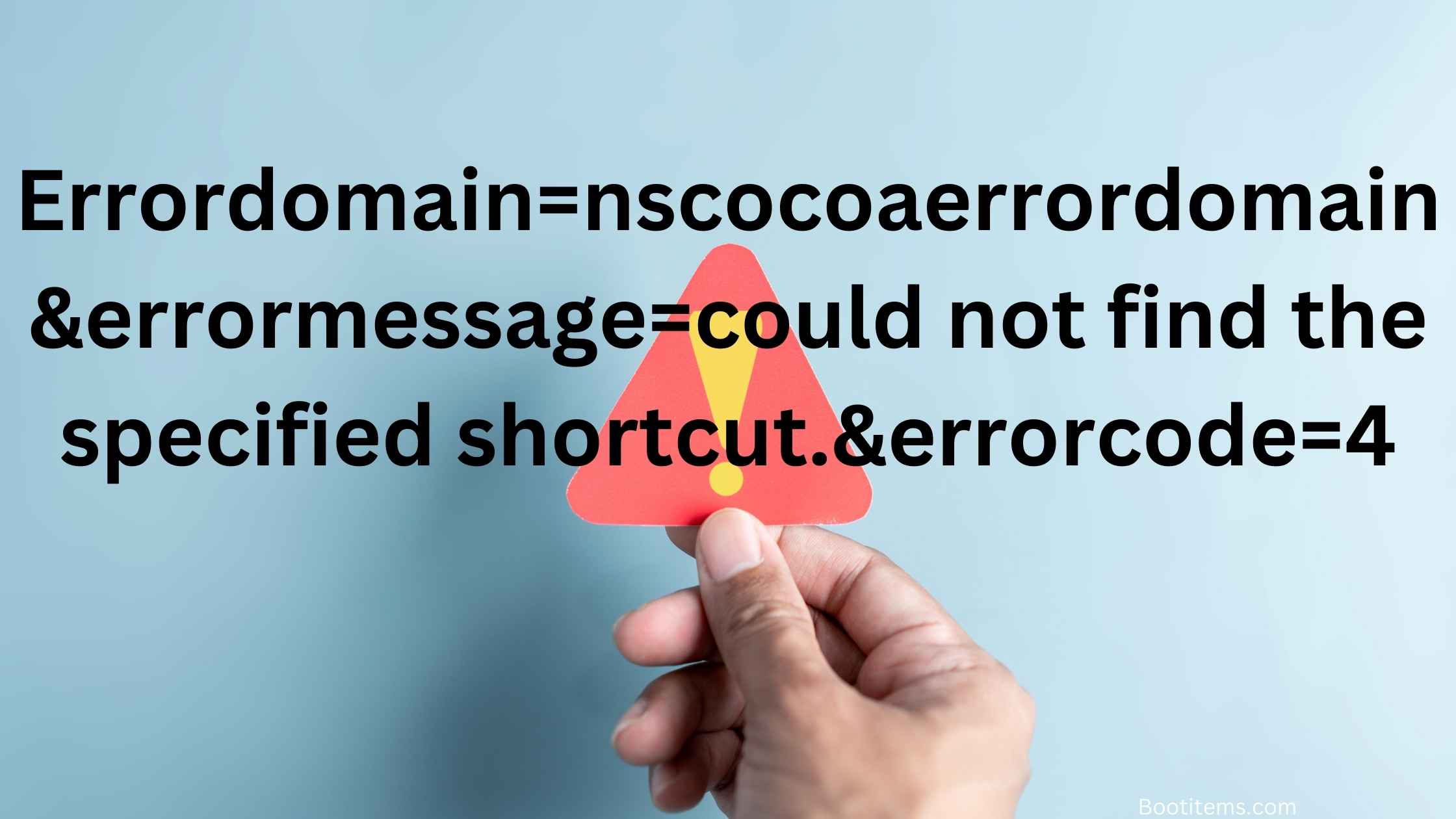
The errordomain=nscocoaerrordomain&errormessage=could not find the specified shortcut.&errorcode=4 error occurs when an application can't find a specific shortcut or file. This issue is common in macOS and iOS systems using the Cocoa framework.
Understanding the NSCocoaErrorDomain Error
The NSCocoaErrorDomain is a part of Apple's Cocoa framework, which is used in macOS and iOS app development. This error domain handles issues related to file management, data persistence, and other core system functions. When an error occurs within this domain, it often indicates a problem with accessing or manipulating files and resources.
Breaking Down the Error Message
The error message contains three main parts:
- Errordomain=NSCocoaErrorDomain: This specifies that the error is within the Cocoa framework.
- ErrorMessage=Could not find the specified shortcut: This explains the nature of the error - a shortcut or file is missing.
- ErrorCode=4: This number corresponds to a specific error type within the NSCocoaErrorDomain.
Error code 4 typically relates to file-related errors, specifically indicating that a file or resource could not be found at the expected location.
Common Causes of the Error
Several factors can lead to this error:
Missing Shortcut File
The most straightforward cause is that the shortcut file no longer exists in the specified location. This can happen if the file was accidentally deleted, moved, or never created in the first place.
Incorrect File Path
If the application is looking for the shortcut in the wrong location, it will trigger this error. This can be due to:
- Typos in the file path
- Changes in the directory structure
- Relative paths that don't resolve correctly
Permission Issues
Even if the shortcut exists, the application might not have the necessary permissions to access it. This can occur due to:
- Restrictive file permissions
- Sandboxing in macOS
- User account limitations
Corrupted Shortcut Files
If the shortcut file itself is corrupted, the system may fail to recognize it, leading to this error.
Software Bugs
In some cases, the error might be caused by bugs in the application or operating system itself, particularly after updates or system changes.
How to Fix the Error
To resolve the errordomain=nscocoaerrordomain&errormessage=could not find the specified shortcut.&errorcode=4 error, you can try several approaches:
Verify the Shortcut's Existence
- Open Finder on your Mac.
- Navigate to the location where the shortcut should be.
- Check if the shortcut file is present.
- If it's missing, you may need to recreate it or restore it from a backup.
Check and Correct the File Path
- Review the application's settings or configuration files.
- Ensure that the path to the shortcut is correct.
- Update any hardcoded paths in the application's code if necessary.
- Use absolute paths instead of relative paths when possible.
Adjust File Permissions
- Right-click on the shortcut file in Finder.
- Select "Get Info."
- In the "Sharing & Permissions" section, ensure that your user account has read and write permissions.
- If needed, click the lock icon and enter your admin password to make changes.
Recreate the Shortcut
If the shortcut is corrupted or missing:
- Delete the existing shortcut (if present).
- Right-click on the original file or application.
- Select "Make Alias" to create a new shortcut.
- Move the new shortcut to the required location.
Update or Reinstall the Application
If the error persists:
- Check for updates to the application causing the error.
- Install any available updates.
- If updating doesn't help, try uninstalling and reinstalling the application.
Check for System Updates
Ensure your macOS is up to date:
- Click on the Apple menu.
- Select "System Preferences" or "System Settings."
- Click on "Software Update."
- Install any available updates.
Use Terminal for Advanced Troubleshooting
For more technical users:
- Open Terminal.
- Use commands like ls, cd, and pwd to navigate and check file structures.
- Use chmod to modify file permissions if necessary.
Preventing Future Occurrences
To minimize the chances of encountering this error in the future:
Implement Robust Error Handling
If you're a developer:
- Add checks for file existence before attempting to access shortcuts.
- Implement fallback mechanisms for missing files.
- Provide clear error messages to users when shortcuts can't be found.
Maintain Regular Backups
- Use Time Machine or another backup solution regularly.
- Keep backups of important shortcuts and their target files.
Document File Structures
- Maintain documentation of your application's file structure.
- Update this documentation whenever changes are made.
Use Version Control
For developers:
- Use version control systems like Git to track changes in file structures and paths.
- This helps in identifying when and why changes were made that might lead to this error.

Impact on User Experience
The errordomain=nscocoaerrordomain&errormessage=could not find the specified shortcut.&errorcode=4 error can significantly impact user experience:
- It can prevent users from accessing certain features or files.
- It may cause applications to crash or behave unexpectedly.
- Users might lose trust in the application if the error occurs frequently.
To mitigate these issues:
- Provide clear error messages to users.
- Offer in-app guidance on how to resolve common causes of the error.
- Implement automatic error reporting to help developers identify and fix issues quickly.
Cryptocurrency Investment and Trading
Technical Deep Dive
For those interested in the technical aspects of this error:
NSCocoaErrorDomain Structure
The NSCocoaErrorDomain is part of the Foundation framework in macOS and iOS. It defines a set of error codes related to file operations, data management, and other core system functions.
Error Code 4 Specifics
Error code 4 in this domain typically corresponds to NSFileNoSuchFileError. This error is thrown when:
- The file system object (file, directory, or symbolic link) doesn't exist.
- The path to the object is invalid.
Relationship to POSIX Errors
In many cases, NSCocoaErrorDomain errors are wrappers around lower-level POSIX errors. Error code 4 often correlates with the POSIX error ENOENT (No such file or directory).
Debugging Techniques
When debugging this error:
- Use NSError objects to capture detailed error information.
- Examine the userInfo dictionary of the NSError for additional context.
- Use tools like Instruments to trace file system accesses and identify where the error occurs.
Best Practices for Developers
To minimize the occurrence of this error in your applications:
Use FileManager Effectively
- Always check for file existence before attempting to access files.
- Use FileManager.default.fileExists(atPath:) to verify paths.
- Implement proper error handling when working with files.
Handle Path Construction Carefully
- Use URL instead of string paths when possible.
- Utilize FileManager.default.urls(for:in:) to get standard directory locations.
- Be cautious when constructing paths, especially when dealing with user-generated content.
Implement Graceful Degradation
- Design your application to function (perhaps with limited features) even if certain shortcuts or files are missing.
- Provide clear feedback to users when resources can't be found.
- Offer options to recreate or relocate missing files when possible.
Regular Testing
- Include file system tests in your unit and integration test suites.
- Test your application under various conditions, including missing files and limited permissions.
FAQs
What does "NSCocoaErrorDomain" mean?
NSCocoaErrorDomain is an error domain used in Apple's Cocoa framework for macOS and iOS. It handles errors related to core system functions, especially file and data operations.
Can this error occur on iOS devices?
Yes, this error can occur on iOS devices as well, since iOS also uses the Cocoa framework. However, it's less common due to the more controlled file system access on iOS.
How can I prevent this error from happening repeatedly?
To prevent recurring errors:
- Regularly check and maintain file paths in your applications.
- Implement robust error handling and logging.
- Keep your applications and operating system updated.
- Use version control for tracking file structure changes.
Is this error always related to missing files?
While often related to missing files, this error can also occur due to permission issues, corrupted files, or software bugs. Always investigate the specific context of the error.
Can antivirus software cause this error?
Yes, in some cases, antivirus software can interfere with file access, potentially causing this error. Try temporarily disabling your antivirus to see if it resolves the issue.
Conclusion
The errordomain=nscocoaerrordomain&errormessage=could not find the specified shortcut.&errorcode=4 error, while frustrating, is often resolvable with the right approach. By understanding its causes and implementing the solutions outlined in this article, users and developers can effectively address and prevent this issue.
Remember that this error is typically a symptom of underlying file system or permission problems. Regular system maintenance, careful file management, and robust error handling in applications can significantly reduce its occurrence.
For developers, this error underscores the importance of thorough testing and error handling in file system operations. By implementing best practices in file management and providing clear user feedback, you can create more reliable and user-friendly applications.
Ultimately, while technical in nature, resolving this error often comes down to basic file system checks and corrections. Whether you're an end-user or a developer, the key is to approach the problem systematically, checking file existence, paths, and permissions until you identify and resolve the root cause.


